Borers
Mango stem borer, Batocera rufomaculata
| Symptoms of damage |
- Grub tunnels in the sapwood on the trunk or branches
- Grub bore into the sap wood and macking irregular tunnels.
- Feeding the vascular tissues
- interruption of nutrient and water transport on the tissue
- Drying of terminal shoot in early stage
- Frass comes out from several points and some times sap oozes out of the holes
- Wilting of branches or entire tree
|
| Identification of pest |
- Grub - Linear, fleshy, apodous
- Adult - Grayish beetle with two pink dots and lateral spine
|
|
| Management |
- Remove and destroy dead and severely affected branches of the tree
- Remove alternate host, silk cotton and other hosts
- Grow tolerant mango varieties viz., Neelam, Humayudin.
- Swab Coal tar + Kerosene @ 1:2 or Carbaryl 50 WP 20 g / l (basal portion of the trunk - 3 feet height) after scraping the loose bark to prevent oviposition by adult beetles.
- If infestations are severe then apply the copper oxychloride paste on the trunk of the tree.
- One celphos tablet (3 g aluminum phosphide) per hole
- Apply carbofuran 3G 5 g per hole and plug with mud.
|
Bark borer, Indarbela tetraonis
| Symptoms of damage |
- Young trees may succumb to the attack.
- Caterpillars bore into the trunk or junction of branches
- Caterpillars remain hidden in the tunnel during day time and come out at night, feed on the bark.
- Presence of gallery made out of silk and frass
|
| Identification of pest |
- Larva - Stout and dirty brown in colour
- Adult
- Stout yellowish –brown moth with brown wavy markings on the forewings
- Hind wings is white colour.
- Males are smaller than the females.
|
| Management |
- Remove and destroy dead and severely affected branches of the tree
- Remove alternate host, silk cotton and other hosts
- Grow tolerant mango varieties viz., Neelam, Humayudin.
- If infestations are severe then apply the copper oxychloride paste on the trunk of the tree.
- One celphos tablet (3 g aluminum phosphide) per hole
- Apply carbofuran 3G 5 g per hole and plug with mud.
|
Shoot borer, Clumetia transversa
| Symptoms of damage |
- Terminal shoots show tunnel from top to down wards.
- Stunting of seedlings with terminal bunchy appearance.
|
| Identification of pest |
- Larva - Caterpillar is dark pink with dark brown prothroacic shield.
- Adult - Adult is greyish moth with grey wings having wavy lines.
|
| Management |
- Field sanitation
- Collect and destroy the infested plant parts
- Summer ploughing to expose the pupae
- Spray carbaryl 50WP 0.1%.
|
INFLORESCENCE AND FRUIT FEEDERS
Mango hoppers, Idioscopus niveoparsus,I. clypealis, Amirtodus atkinsoni
| Symptoms of damage |
- Nymphs and adults suck the sap of inflorescence
- Withering
- Shedding of flower buds and flowers
- Presence of honey dew secrecation on lower leaves and development of sooty mould.
- Clicking sound - movement of jassids amidst leaves.
- Hoppers provide shelter in the cracks and crevices of the barks on the tree
|
|
| Identification of pest |
- Nymph - Nymphs pale yellow, very active and hide in lower shoots or in cracks in the barks.
- The insect appears in February when mango trees come to flowering.
- Adult
- a. Idioscopus niveoparsus; Adults: dark with wavy lines on wings and three spots on scutellum.
- b. I. clypealis; Adults: small, light brown with dark spots on the vertex and two spots on scutellum.
- c. Amirtodus atkinsoni; Adults: large, light brown with two spots on scutellum.
|
| Management |
- Avoid close planting, as the incidence very severe in overcrowded orchards.
- Orchards must be kept clean by ploughing and removal of weeds.
- Spray two rounds of acephate 75 SP@ 1g/lit or phosalone 35 EC@ 1.5 ml/li
OR
- First spray at the time of panicle emergence , second spray two weeks after first spray.
- Wettable sulphur @ 2 g/lit may be sprayed after spraying carbaryl to avoid mite resurgence.
- The mixture toxaphene with sulphur (1:1) have been reported to be effective against pest.
- Neem oil 5 ml/lit of water can be mixed with any insecticides
- Spray 3 per cent neem oil or neem seed kernel powder extract 5 per cent
|
Inflorescence midge
| Symptoms of damage |
- Maggots attack the inflorescence stalk, flowers and small developing fruits
- Maggot bore into the bud and feeds on inner content
- Buds fail to open and drop down
|
| Identification of pest |
- Larva - A maggot light yellowish colour and moults three times.
- Adult i) a Dasineura amaramanjarae: Orange red
ii) b. Erosomyia indica: Yellowish fly
iii) c. Procystiphora mangiferae: Light orange fly
|
| Management |
- Remove and destroy affected flowers and tender shoots
- Spray dimethoate 30 EC @ 0.06%, methyl demeton 25 EC @0.05%
|
Aphid, Toxoptera odinae
| Symptoms of damage |
- Reddish brown aphids suck the sap from leaves, petiole and fruits
- Shedding of flowers.
|
| Management |
- Collect and destroy the damaged plant parts along with nymphs and adults
- Dimethoate 30 EC or methyldemeton 25 EC 1 ml/l
- Release coccinelid predators
|
Flower webber, Eublemma versicolor
| Symptoms of damage |
- Webbing of flowers and bore holes in inflorescence stalk
|
| Identification of pest |
- Larva - Greenish yellow with light brown head.
- Adult - Moth has purplish pink or light orange wings.
|
| Management |
- Spray phosalone 35 EC 2ml/lit for effective control
|
Loopers, Thalassodes quadraria, Chloroclystis sp
| Symptoms of damage |
- Webbed inflorescence and subsequent drying of inflorescence.
|
| Identification of pest |
a. Thalassodes quadraria:
- Grey greenish looper.
- Adult: green with angular wings
b. Chloroclystis sp:
- Brownish looper .
- Adult: Greyish moth with wavy lines
|
| Management |
- Collect and destroy the damaged leaves
- Use light trap 1/ha to attract and kill the adults
- Spray malathion 50 EC 2ml/lit
|
Bud mite, Aceria mangiferae
| Symptoms of damage |
- Malformed leaves
- Buds giving bunchy top appearance
- Leading to bud necrosis. Normally occurs during summer.
|
| Management |
- Dicofol 18.5 EC 2.5ml/lit or wettable sulphur 50WP 2 g /lit
|
Fruit fly, Bactrocera (Dacus) dorsalis
| Symptoms of damage |
- Maggot bore into semi-ripen fruits with decayed spots and dropping of fruits.
- Oozing of fluid
- Brownish rotten patches on fruits.
|
 |
 |
| Maggots of fruit fly dropping out of mango fruit |
Mango fruit fly |
|
| Identification of pest |
- Larva - Yellowish apodous maggots.
- Adult - Light brown with transparent wing
|
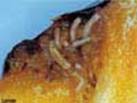 |
 |
| Maggot |
Adult |
|
| Management |
- Collect fallen infested fruits and dispose them by dumping in a pit
- Provide summer ploughing to expose the pupa
- Monitor the activity of flies with methyl eugenol sex lure traps.
- Bait spray - combing any one of the insecticides and molasses or jaggery 10 g/l,
- fenthion 100EC 1ml/l,
- malathion 50EC 2 ml/l,
- dimethoate 30 EC 1 ml/l,
- carbaryl 50 WP 4 g/l. two rounds at 2 weeks interval before ripening of fruits.
Biological control
- Field release of natural enemies Opius compensates and Spalangia philippines
|
Mango nut weevil, Sternochaetus mangiferae
 |
 |
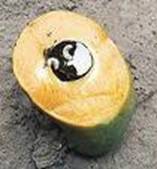 |
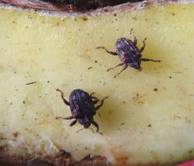 |
Symtom |
Grub |
Grub on mango |
Adult on Mango |
| Symptoms of damage |
- Grub makes zigzag tunnels in pulp
- Eats unripe tissue and bore into cotyledons
- Fruit dropping at marble stage
- oviposition injuries on marble sized fruits.
- Tunnelled cotyledons in mature fruit by grubs.
|
| Identification of pest |
- Grub - A full grown grub is legless, fleshly and yellow with dark head.
- Dark weevils after emergence remain inactive, hidden in the cracks and crevices on the trunk
- Adult - Adult is dark brown with a short snout.
|
| Management |
- Collect and destroy the fallen fruits
- Spray application of fenthion 100EC 1ml/l; (first at marble stage of the fruit second at 15 days interval).
- During non flowering season direct spray towards the base of the trunk
|
LEAF FEEDERS
Shoot webber: Orthaga exvinacea
| Symptoms of damage |
- Caterpillar webbing of terminal leaves and scrapes the chlorophyll content
- Drying up plants.
|
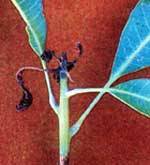 |
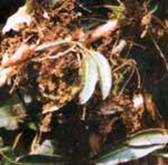 |
 |
| Tip dry |
Inflorescence entangled |
Nest of dried leaves |
|
| Identification of pest |
- Larva - Pale greenish with brown head and prothroacic shield.
- Adult - Brown moth with wavy lines on fore wings.
|
| Management |
- Remove and destroy the webbed leaves along with larva and pupa
- Spray carbaryl at 50 WP @ 0.1%
- Encourage the activity of predators, carabid beetle Parena lacticincta, reduvid Oecama sp
|
Leaf gall midges
| Symptoms of damage |
- Presence of galls on leaves.
|
| Identification of pest |
- Maggots – are yellowish
- Adult - Tiny mosquito like.
|
| Management |
- Spray dimethoate 30 EC or methyldemeton 25 EC @ 2ml/lit.
|
Leaf twisting weevil, Apoderus tranquebaricus
| Symptoms of damage |
- Twisting, rolling and drying of terminal leaves.
|
| Identification of pest |
- Grub: yellowish
- Adult: Reddish brown weevil with long snout
|
Hairy caterpillars, Euproctis fraterna , Prothesia scintillans
| Identification of pest |
- Euproctis fraterna
- Larva - yellowish with brown head, yellowish stripe with central red line
- black hairs dorsally on first three segments
- Adult - yellowish moth with black spots.
|
Prothesia scintillans
- Larva - Reddish with red head surrounded by whitish hairs
- Adult - yellowish moth with transverse line on the fore wings.
|
| Management |
- Collect and destroy egg masses and caterpillars
- Use burning torch to kill the congregating larvae
- Use light trap to attract and kill the adults
- Spray chlorpyriphos 20 EC or quinalphos 25 EC 2ml/lit
|
Scales
| Symptoms of damage |
- Both nymphs and adults desap the leaves cause yellowing.
|
| Identification of pest |
- Adult - White, elongate, hard scale
|
| Management |
- Pruning of infested branches and burning
- Dimethoate or phosphomidon are effective
|
|
Gaint mealybug, Drosicha mangiferae
| Symptoms of damage |
- Drying of leaves and inflorescence
- Presence of pinkish nymphs and adult mealy bugs on fruit and fruit stalk.
|
| Management |
- Remove weeds like Clerodendrum inflortunatum and grasses by ploughing during June-July.
- Band the trees with 20 cm wide alkalthene of polythene (400 gauge) in the middle of December
(50 cm above the ground level and just below the junction of branching).
- Stem with jute thread and apply a little mud of fruit tree grease on the lower edge of the band.
- If necessary apply methyl parathion1ml/lit, chlopyriphos 20EC 2.5 ml/l
- Release of Australian ladybird beetle, Cryptolaemus montrouzieri @ 10/tree
|
Red ant, Oecophylla smaradina
| Symptoms of damage |
- Webbed of leaves with ants forming nests.
|
| Identification of pest |
- Reddish ant, queen – olive green in colour
|
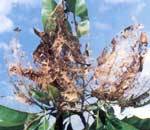 |
| Management |
- Nests should be removed and destroyed mechanically or by spraying any of the contact insecticides
|

